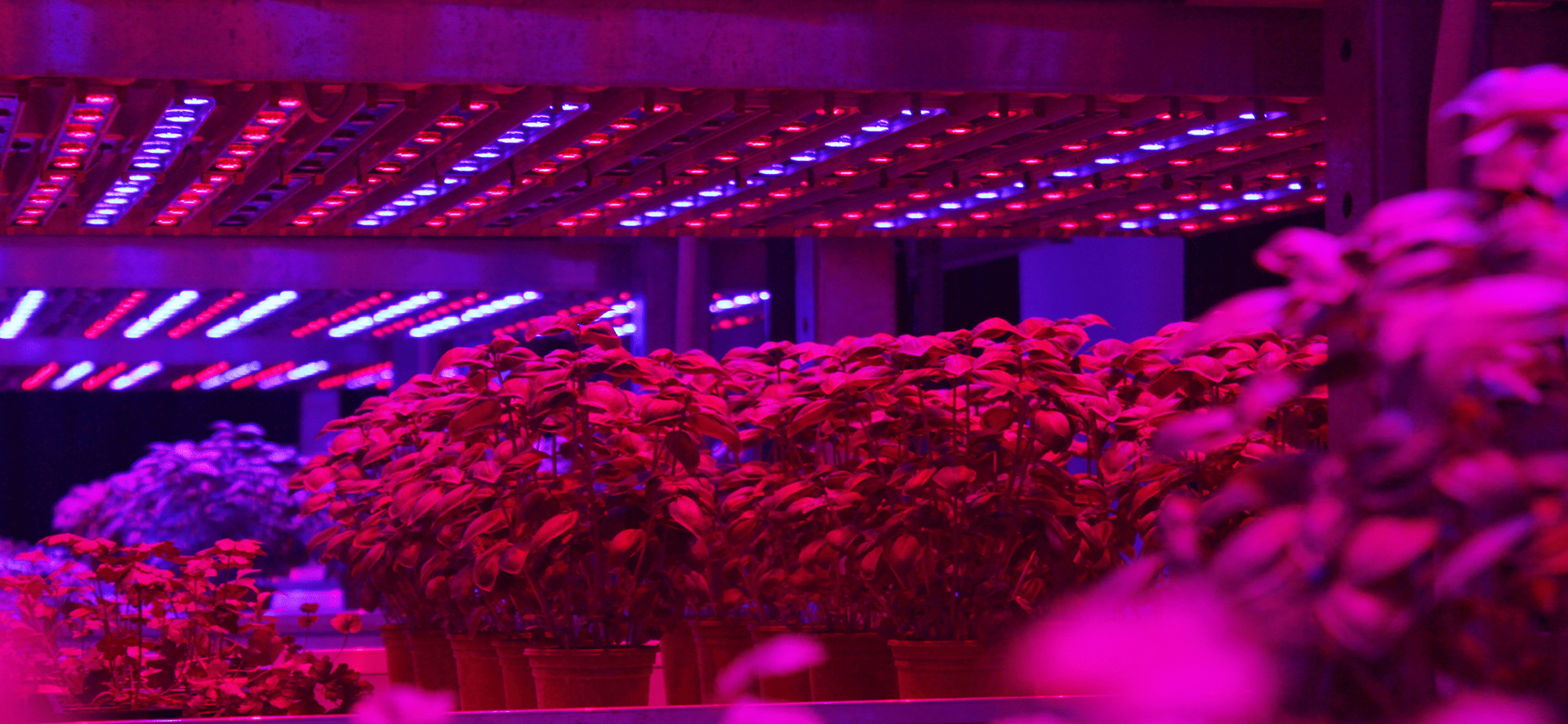
Test

Farming is not always seen as a fast-moving, technology-driven industry but times are changing, and agriculture must keep pace. It needs to produce good-quality, high-yield crops while also meeting the challenges of the 21st century, including a growing global population, climate change and environmental concerns.
For these reasons, many food producers are realising the benefits of a technology-based approach to food production, including controlled environment agriculture (CEA) for crops that can be grown under cover. Across the country vast greenhouses are being built, some taking up several hectares, which light up the night skies thanks to their brightly coloured – usually pink – LED lighting systems. These are the new kids on the block.
Essentially CEA protects a crop from the elements, including extremes of heat or cold, rain or drought and wind. It allows growers to maintain optimal conditions throughout a crop’s development, and in doing so, to increase the rate of growth, prolong the growing season and multiply the number of possible harvests in a year.
As everything happens within an enclosed growing structure, such as a greenhouse or other building, CEA, particularly Vertical Farming, ensures produce can be grown any time, any place, whatever the weather. Increasingly, plants are grown without soil, with nutrients supplied direct to the root, thereby increasing the amount of nutrients taken up by the plant and providing stronger, faster growth.
LED lights allow for a longer growing period each day, using light recipes, scientifically-tested colour spectra adapted to the particular type of crop, to enhance growth, optimise yields and improve flavour and nutrition.
And not only that, CEA optimises the use of resources. Water is recycled via recirculation, and energy use is minimised by using low-energy LED bulbs that give off less heat, reducing the need for cooling systems. Land space is maximised as crops are grown in multiple layers, one above the other. Finally, the protected nature of CEA minimises pest and disease risk and reduces the need for crop protection chemicals. This growing of ‘clean’ crops also allows produce to be packed immediately, as they will not need to be washed. Labour-saving robots can even be used to monitor or harvest crops.
CEA technologies include hydroponics, aeroponics, aquaculture, and aquaponics. More recently, the advent of Vertical Farming – the growing of fruit, vegetables and medicinal ingredients on stacks of shelves indoors – is making it possible to grow food in places that never get any natural light. CHAP member LettUs Grow in Bristol, and Growing Underground, in London, are both based in disused railway tunnels, while Jones Food Company, in Lincolnshire, has adapted an unoccupied cold-storage warehouse. In the US, growers are using multi-storey buildings, basements and rooftops.
But why are people turning to Vertical Farms, and can they realistically help to feed the world’s growing population? It is argued that the extra harvests and reduced growing time, through optimising environmental conditions, allow growers to produce many times the crops possible in the same area of conventional farm fields.
In an episode of Radio 4’s environment programme Costing the Earth broadcast in April this year, Valefresco’s Nick Mauro said that the firm, which uses a tower-growing system housed in a polytunnel, could grow up to 300 tonnes of strawberries per hectare, compared to a traditional yield of 18-32 tonnes, increasing the harvest by anything from nine-16 times. He also told the show’s presenter, BBC Rural Affairs Correspondent Tom Heap, that their fully closed system used about 95 per cent less water than the global average, with nutrient-rich water coming in, flowing through, coming out at the bottom, and going back to the tank.
Of course, there is a price to pay. Artificial light is not free, neither are hydration systems nor the technology used to ensure healthy crops. British farmers growing crops out in the field, can make full use of the UK’s rain and sun for free. A report by Business Wales – Vertical Farming: A new future for food production? – states: ‘at the moment more carbon is emitted as a result of CEA production than conventional techniques’. However, it qualifies this by adding: ‘This effect may be offset by the application of renewable energy sources.’
There are, naturally, critics who point out that vertical farms currently grow herbs and leafy greens, which will never be sufficient to feed the world. If this system is to stand the test of time, it needs to cut costs, reduce its carbon footprint and, crucially, expand into growing a wider variety of crops.
There are many pioneering firms working to make this happen. Some, including Bioaqua Farm and CHAP member Farm Urban, combine the farming of fish and crops using an aquaponic system. This not only uses nitrates recovered from the fish-tank waste water to feed the crops, but also recycles the water back to the fish tanks.
Many of the advances are in the lighting systems crucial to the system. Liberty Produce in Scotland, one of CHAP’s partner organisations, has developed a high-efficiency, dynamic LED system with improved lighting control, optimising lighting solutions for plant growth and nutritional content, including spectral combinations and intensities. The same firm is also developing nutrient enhancement technologies.
The system developed by Scottish vertical farming start-up Intelligent Growth Solutions (IGS), allows large-scale LED lighting to be run on high power loads, reducing the costs compared to typical vertical farms that use single-phase power supplies. This advance could help to expand the variety of crops grown in vertical farms. In an article reporting the firm’s huge funding input from a US backer, the Financial Times quoted chief executive David Farquhar’s aspirations for Scottish farmers to use its system to grow an increasing variety of produce, including ‘fruit, potatoes and broccoli’.
The Business Wales report, mentioned above, states that using renewable energy could help vertical farms to ‘reduce the carbon footprint enough to equal or exceed conventional production’. It also points out that vertical farms do not need good agricultural land to grow – they can ‘take advantage of low value land otherwise unavailable for food production’. Many major horticultural growers, such as APS Group and Anglia Salads, are now using anaerobic digestion with combined heat and power (AD-CHP) as a renewable energy source for their CEA facilities. Other growers, such as CHAP member Plant Raisers, are using photovoltaic cells in conjunction with their CEA facilities.
Jones Food Company is based in a well-insulated, cold-storage warehouse near Scunthorpe, in Lincolnshire, meaning the building costs were minimal and the operating costs are minimised. It controls the air, pumping pure CO2 into the building, all the water it uses is recycled and its LED lights are powered by renewable energy. It can produce 10 crops a year, with growing trays stacked 17 levels high.
Vertical farming certainly has some impressive figures to play with, and it seems these figures are attracting interest from big investors including Ocado (invested £17m buying a majority stake in Jones Food Company), Emirates (partnering with California-based CropOne to build a $40m vertical farm in Dubai to grow food for airline passengers) and US-based S2G Ventures, a leading agri-food tech investor (invested £5.4m in IGS).
It is true that vertical farming, as it currently stands, cannot feed the world, but it can certainly help. While it cannot be used for broad-acre crops, it can free-up good quality land for such crops. We could soon see half of the leafy green vegetables we consume coming from vertical farms. These farms could also be used for an expanding variety of crops, such as strawberries, potatoes, rice, coffee and vanilla.
Vertical farming enables us to grow food in areas where it has not previously been possible, with multiple harvests in a year and greatly increased yields. By any measure, that has to be a good thing and CHAP is working in CEA with its partners Liberty Produce and the James Hutton Institute at the IHCEA capability in Dundee, Stockbridge Technology Centre with the Vertical Farming Development Centre near York, and RIPE and Warwick University with the Natural Light Growing Centre at Wellesbourne.
All these capabilities, funded by CHAP working with InnovateUK, aim to develop advanced vertical farming technology and expertise, to ensure the UK is at the forefront of the industry. In this way we are working towards the shared goal of helping to feed the country and the world, and also making the UK a world leader, exporting both the technology and the expertise worldwide.
IHCEA carries out development, testing and research into next-generation technologies to improve the cultivation of indoor and protected crops
CHAP has partnered with Liberty Produce to establish the Innovation Hub for Controlled Environment Agriculture (IHCEA) which is housed at Liberty’s Future Farming Hub on site at the James Hutton Institute, Invergowrie.
click below for more details
CHAP has partnered with RIPE building services Ltd to realise the development of a new approach to commercial protected crop production utilising full UV spectrum natural daylight.
click below for more details
CHAP’s Vertical Farming Development Centre is housed at Stockbridge Technology Centre (STC), near Selby, and provides additional and complementary capabilities to STC’s existing LED4CROPS facilities.
click below for more details
CHAP plays a key role in developing new control strategies, which are going to be essential for the farmers and growers who are having to deal with the loss of actives in the market.
- Dr Tom Ashfield , Rothamsted Research
For more information on our capabilities or to discuss a collaboration and/or grant for a commercially funded project, complete the form below.

© 2019 CHAP - Crop Health and Protection Limited
Test